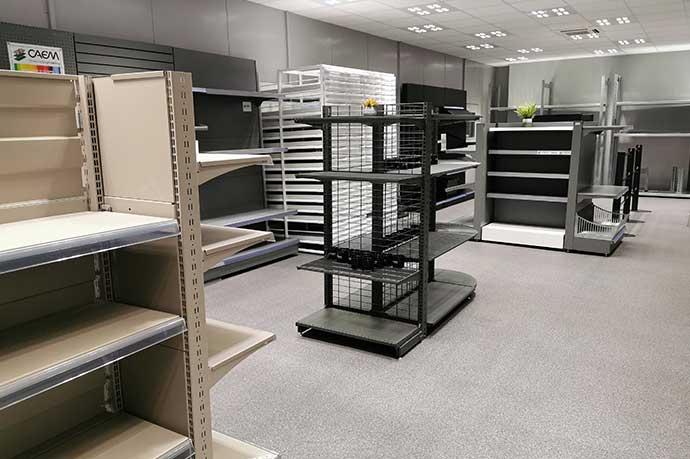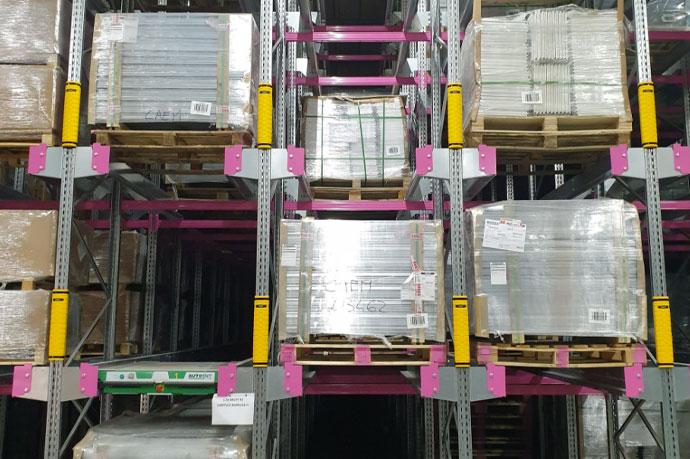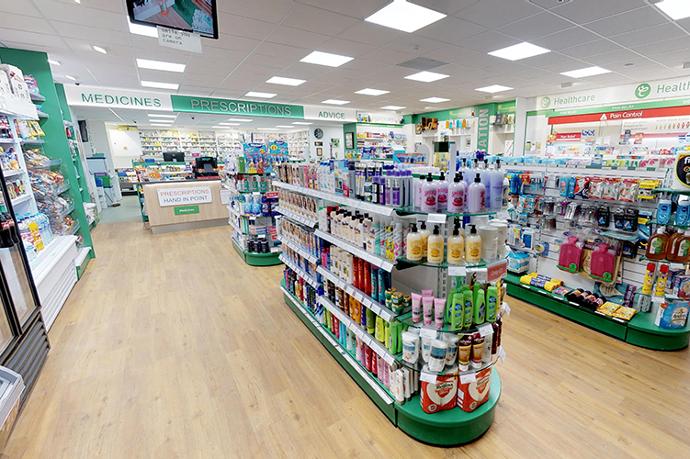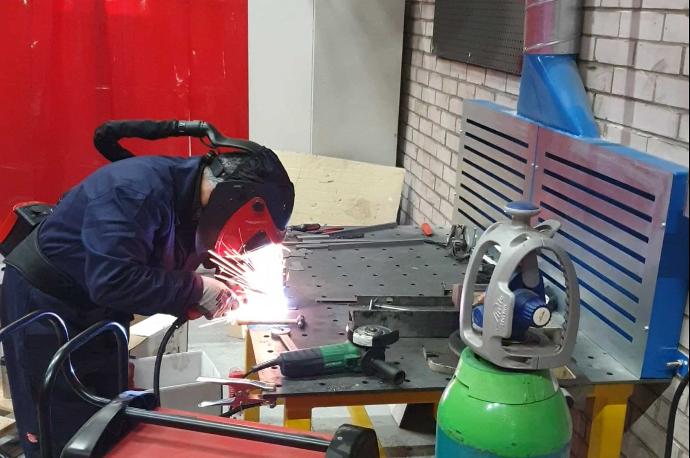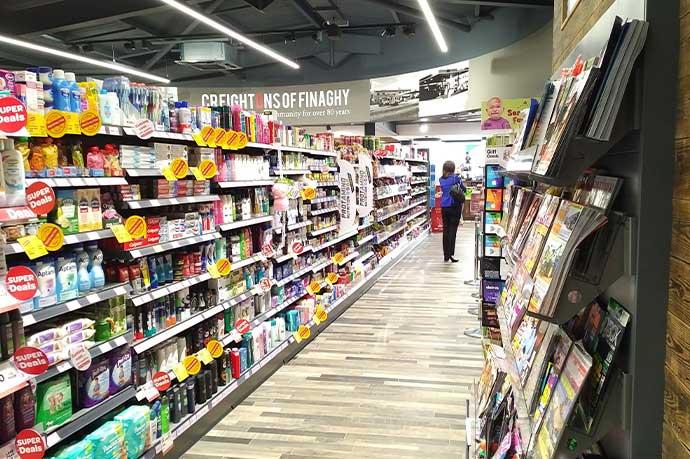Navigating the bustling aisles of a supermarket, one might not immediately consider the silent yet significant role played by supermarket shelving. These structures do more than hold products; they shape the shopping experience and influence purchasing behavior. With the retail shelving system market poised to reach a staggering valuation of $5,610.6 million by 2033, growing at a CAGR of 8.8%, it's clear that supermarket shelving is a vital component in retail strategy. This article delves into the top retail solutions for supermarket shelving, exploring their evolution, types, and future trends.
Understanding Supermarket Shelving: An Introduction
The Importance of Efficient Shelving in Supermarkets
Efficient shelving is the backbone of any successful supermarket. It maximizes space, ensuring products are displayed attractively to boost sales. Thoughtfully designed shelving aids customer navigation, significantly influencing purchasing decisions. When items are organized systematically, customers can easily locate what they need, enhancing satisfaction and operational efficiency. Retailers must prioritize shelving solutions that balance aesthetics and functionality to maintain a competitive edge.
A Brief History of Supermarket Shelving
Supermarket shelving has come a long way from its humble beginnings. Initially, simple wooden structures were the norm, but as retail environments evolved, so did the need for more sophisticated shelving systems. Modern supermarket shelving now boasts advanced, modular designs that cater to diverse product ranges. Innovations in shelving have been driven by the demand for increased durability, flexibility, and visual appeal. Over time, these advancements have aligned with shifts in consumer behavior and the changing landscape of retail, providing adaptable solutions for both large supermarkets and smaller stores. Companies like CAEM, established in 1958, have been at the forefront of these developments, offering unrivaled shelving and shop format solutions in the UK since 1989. Their expertise highlights the dynamic nature of retail display evolution and its critical role in enhancing the shopping experience.
Types of Supermarket Shelving
In the world of retail, supermarket shelving is not just about storage; it's a strategic tool for enhancing product visibility and customer experience. With diverse options available, choosing the right type can significantly impact a store's success. Let's explore some popular types of supermarket shelving and their unique advantages.
Gondola Shelving
Gondola shelving is a staple in supermarkets, known for its versatility and dual-sided display capability. This modular system allows retailers to easily customize and reconfigure layouts to maximize floor space and create efficient aisles. It's particularly effective for showcasing a wide variety of products. CAEM, a leader in retail display solutions, specializes in manufacturing gondola shelving systems. Their designs are tailored to meet specific retailer needs, offering bespoke solutions with quick turnaround times.
End Cap Display Shelving
End cap display shelving is strategically positioned at the ends of aisles to draw attention to promotional or high-margin items. These units are powerful tools for driving impulse purchases, often featuring seasonal products or special offers. By highlighting key items, end caps play a crucial role in a supermarket's marketing strategy, enhancing product visibility and customer engagement.
Wall Shelving Units
Wall shelving units make efficient use of vertical space, ideal for displaying products along the store's perimeter. They help keep the floor space clear and organized, providing an excellent platform for products that need more visibility. These units are particularly suited for smaller or niche items, offering a tidy and accessible display that enhances the shopping experience.
Pegboard and Slatwall Shelving
Pegboard and slatwall shelving provide flexible display options with adjustable hooks and shelves, perfect for hanging products or showcasing merchandise neatly. Retailers can quickly adapt these displays to suit dynamic product assortments, making them ideal for stores with frequently changing inventory. This adaptability ensures that products remain attractively displayed and accessible to customers.
Custom Shelving Solutions
Custom shelving solutions are tailored to meet the unique requirements of individual retailers, accommodating specific product sizes or store layouts. These bespoke designs offer enhanced branding opportunities and can incorporate innovative materials and technologies to optimize space and improve the shopping experience. CAEM's expertise in developing complete store formats with hundreds of custom display solutions demonstrates the value of personalized shelving in retail success.
As the global shelving units shelves market is projected to grow at a CAGR of 5.90% from 2023 to 2030, it's clear that investing in the right supermarket shelving solutions is more crucial than ever. The Asia Pacific region, holding the largest market share at 33%, underscores the importance of these systems in supporting the dynamic and ever-evolving retail landscape.
Key Features and Benefits of Modern Supermarket Shelving
In today's competitive retail environment, the features and benefits of supermarket shelving have evolved to meet the dynamic needs of retailers and enhance the shopping experience. Modern shelving systems offer several advantages that can significantly impact store operations and customer satisfaction.
Durability and Load Capacity
Modern supermarket shelving is crafted from robust materials, ensuring it can withstand heavy loads and frequent use. This durability not only extends the lifespan of the shelving but also minimizes maintenance costs over time. With high load capacities, retailers can confidently stock a wide array of products without worrying about safety or structural integrity. CAEM, for instance, excels in manufacturing durable gondola shelving systems, designed to meet the rigorous demands of busy retail environments.
Adjustability and Versatility
The adjustability of modern shelving systems allows retailers to modify shelf heights and configurations to suit various product sizes and categories. This versatility makes it easy to reorganize displays and adapt to changing inventory needs, ensuring optimal use of space. CAEM's TN9 modular shelving system exemplifies this flexibility, offering a unique and versatile upright design that caters to diverse merchandising requirements.
Aesthetics and Branding Opportunities
Aesthetic elements are integral to contemporary supermarket shelving, as they enhance store branding and create a visually appealing shopping environment. Customizable finishes and colors enable retailers to align shelving with their brand identity, contributing to a cohesive store atmosphere. CAEM offers an impressive range of color options, with 15 standard finishes and over 100 additional choices, allowing for personalized and attractive shelving solutions that resonate with customers.
Ease of Assembly and Maintenance
Modern shelving units are often designed for quick assembly and disassembly, which reduces installation time and labor costs—a significant advantage during store remodels or relocations. Easy maintenance ensures that shelving remains clean and presentable, supporting overall store hygiene and enhancing customer satisfaction. CAEM's commitment to bespoke solutions, supported by their R&D and design teams, ensures that retailers receive shelving that is not only functional but also easy to manage.
By integrating these key features, supermarket shelving becomes more than just a functional necessity; it transforms into a strategic asset that supports branding, efficiency, and customer engagement. As a financially robust company with over 30 years of experience in the UK, CAEM continues to lead the way in providing innovative and adaptable shelving solutions tailored to the unique needs of each retailer.
The Role of Shelving in Maximising Store Layout and Design
Shelving plays a crucial role in the overall design and functionality of a supermarket. By optimizing space and enhancing customer flow, shelves transform a simple retail environment into an efficient, customer-friendly shopping destination. Let's explore how effective shelving for supermarkets can elevate store layout and improve the shopping experience.
Shelves as Tools for Space Optimisation
In the quest to maximize limited floor space, particularly in urban environments, innovative retailers are increasingly turning to vertical shelving solutions. These shelves allow supermarkets to make full use of available space, facilitating strategic product placement and supporting inventory management. By organizing products logically, shelving helps streamline the shopping journey, guiding customers seamlessly through various sections. This efficient use of space is especially critical in Class A convenience stores, which dominate the global retail shelving systems market with an expected CAGR of around 9% during the forecast period.
Enhancing Customer Flow and Experience
Strategically designed shelving arrangements are key to improving customer navigation and reducing congestion within the store. Clear pathways, facilitated by well-placed shelves, ensure that customers can easily access products, contributing to a more pleasant shopping experience. Moreover, customer-centric layouts often incorporate end cap displays and strategically positioned shelving to highlight key products and promotions, encouraging impulse purchases and boosting sales. By focusing on intuitive layouts, retailers create environments that not only enhance customer satisfaction but also drive purchasing behavior.
In summary, the strategic use of shelving for supermarkets is integral to creating efficient and inviting store layouts. By optimizing space and enhancing the shopping experience, retailers can better meet the needs of their customers while maximizing their sales potential.
Materials and Innovation in Supermarket Shelving
The evolution of supermarket shelving is closely tied to advancements in materials and technology. As retailers strive for efficiency and sustainability, the choice of materials and the incorporation of cutting-edge technology play pivotal roles in shaping modern shelving solutions.
Traditional Materials vs. Modern Alternatives
Traditionally, supermarket shelving relied heavily on wood and metal, valued for their strength and durability. Today, these materials are complemented by modern alternatives like composite materials and recycled plastics. These new options offer enhanced sustainability and durability while maintaining the aesthetic appeal crucial for retail environments. The choice of materials not only affects the functionality and look of the shelving but also its environmental footprint. Notably, material accounts for more than 60% of the value share in the retail shelving market, favored for its ability to support both light and heavy weights and its affordability compared to aluminum.
Technological Advancements in Shelving
Technological innovations have transformed supermarket shelving into smart, interactive systems. The integration of sensors and digital displays into shelving units allows for real-time inventory management and customer engagement. These advancements provide retailers with tools for data collection, enabling improved stock management and personalized shopping experiences. Interactive digital screens can display product information, promotions, and even augmented reality experiences, enriching the shopping journey.
Eco-friendly shelving solutions are also gaining traction, with retailers incorporating recycled materials and energy-efficient designs. Companies like CAEM are at the forefront of these innovations, offering bespoke solutions that integrate sustainability with state-of-the-art technology. With a strong team of designers and advanced manufacturing capabilities, CAEM continues to push the boundaries of what's possible in supermarket shelving, ensuring that retailers can meet the demands of modern consumers while minimizing their environmental impact.
Choosing the Right Shelving for Your Supermarket
Selecting the ideal shelving for supermarket environments requires careful consideration of several key factors. From assessing your store’s unique needs to budget planning and professional collaboration, making informed decisions can greatly enhance both functionality and customer experience.
Assessing Your Store’s Needs
To choose the right supermarket shelving, start by evaluating your store's size, product range, and customer demographics. These factors will guide you in selecting shelving solutions that align with your business goals and operational requirements. Consider how store traffic patterns and product turnover rates influence the types of shelving configurations you need. For instance, high-traffic areas might benefit from durable, easily adjustable shelves that accommodate frequent restocking and varied product sizes.
Budget Considerations
Budget constraints are a crucial aspect of shelving selection. It's important to strike a balance between cost-effectiveness and quality. Investing in durable and adaptable shelving systems can offer long-term value, even if the initial outlay is higher. Retailers should explore bulk purchasing options and seek competitive pricing to manage costs without compromising on quality. With the retail shelving market projected to grow from USD 2,643.22 million in 2024 to USD 5,170.83 million by 2031, it's clear that investing wisely in supermarket shelving is essential for staying competitive.
Working with Professional Designers and Providers
Collaborating with professional designers and shelving providers can lead to tailored solutions that enhance both store aesthetics and functionality. These experts bring invaluable insights into space planning and product placement, ensuring that shelving installations optimize the shopping environment. Companies like CAEM, with their state-of-the-art manufacturing facility in the UK, offer high-quality retail solutions for large-scale fit-out projects. Their in-house design team excels in bringing retail store concepts to life, designing and prototyping retail display solutions that meet specific needs. Partnering with such professionals ensures compliance with safety standards and enhances the overall customer experience, aligning with the growing consumer desire for organized commerce.
Installation and Maintenance Best Practices
Proper installation and regular maintenance of supermarket shelving are crucial for ensuring safety, functionality, and longevity. Adhering to best practices can help retailers optimize their shelving investments and maintain an efficient store environment.
Step-by-Step Installation Guide
Installing supermarket shelving requires careful planning and precise execution. Begin by reviewing the manufacturer’s instructions and safety guidelines to ensure all components are correctly assembled and securely anchored. Here’s a step-by-step guide to streamline the process:
- Preparation: Clear the installation area and gather necessary tools and materials. Check that all shelving components are present.
- Layout Planning: Map out the shelving configuration to align with the store layout, ensuring optimal use of space and accessibility.
- Assembly: Follow the manufacturer's instructions to assemble the shelving units. Ensure each unit is level and stable.
- Anchoring: Securely anchor the shelves to the floor or walls as required, especially for taller units, to prevent tipping.
- Final Adjustments: Make any necessary adjustments to ensure shelves are straight and properly aligned.
A systematic approach minimizes disruptions and facilitates seamless integration into the store layout. CAEM’s vertically integrated manufacturing process, which includes in-house design and fabrication, ensures that their standard shelving systems are available with short lead times, often deliverable in as quickly as 7 working days, providing retailers with timely solutions.
Regular Maintenance Tips for Longevity
Routine maintenance is essential for extending the lifespan of supermarket shelving and maintaining its appearance. Here are some tips to keep your shelves in top condition:
- Regular Cleaning: Clean shelving units regularly to remove dust and debris. Use appropriate cleaning agents to prevent damage to finishes.
- Inspection: Periodically inspect shelves for signs of wear and tear, such as rust or loose fittings. Address issues promptly to prevent further damage.
- Maintenance Schedule: Implement a maintenance schedule to ensure consistent upkeep. Regular checks help identify potential issues early, keeping shelves functional and safe.
By following these best practices, retailers can ensure their supermarket shelving remains durable, safe, and visually appealing, contributing to a positive shopping experience for customers.
Future Trends in Supermarket Shelving
As the retail landscape evolves, supermarket shelving is at the forefront of innovation, driven by sustainability and smart technology. These trends are reshaping how retailers manage inventory, engage customers, and reduce their environmental footprint.
Sustainability and Eco-Friendly Options
The push for sustainability is prompting retailers to seek eco-friendly supermarket shelving solutions. This growing demand is leading to innovations in recyclable materials and energy-efficient manufacturing processes. Retailers are increasingly adopting shelving made from sustainable resources, such as recycled metals and plastics, to minimize environmental impact. These efforts not only appeal to environmentally conscious consumers but also align with broader corporate sustainability goals. By integrating eco-friendly options into their store designs, retailers can enhance their brand image and contribute positively to environmental conservation.
Integration of Smart Technology
Smart technology is revolutionizing supermarket shelving, offering features that enhance both operational efficiency and customer experience. Electronic shelf labels (ESLs) and IoT-enabled shelves are transforming inventory management and pricing strategies. These technologies allow for real-time updates and dynamic pricing, streamlining store operations. Furthermore, smart shelving systems are equipped with data-driven capabilities that optimize product placement and shelf space allocation, maximizing sales potential. Some retailers are even exploring personalization through technology, using smart shelving to offer tailored recommendations or pricing based on individual customer data.
Health and safety considerations are also influencing shelving design, with a focus on hygiene and ease of maintenance. In response to global events, there's a trend towards shelving that promotes better hygiene standards, ensuring a safer shopping environment. Modular and flexible designs are becoming essential, enabling retailers to quickly adapt to changing product assortments and seasonal demands. By embracing these technological advancements, retailers can create a more engaging and efficient shopping experience while gaining valuable insights into consumer behavior.
Frequently Asked Questions About Supermarket Shelving
Navigating the complexities of supermarket shelving can be daunting, especially for first-time store owners. This section addresses common issues and provides practical tips to ensure your shelving systems meet your store's needs effectively.
Common Issues and Troubleshooting
Supermarket shelving can face several common issues, such as misalignment, instability, and damage from heavy loads. These problems often arise from improper installation or excessive weight on shelves. Regular inspections are crucial for identifying signs of wear and tear early. If misalignment or instability is detected, check that all components are securely fastened and adjust as necessary. For shelves bearing heavy loads, ensure they are designed to handle the weight and redistribute products if needed to maintain balance.
Understanding the root causes of these issues is essential to prevent recurrence. Implementing a routine maintenance schedule will help maintain the structural integrity of your shelving, ensuring it remains safe and effective for daily operations.
Tips for First-Time Supermarket Owners
For those new to the supermarket business, selecting the right shelving is a critical step. Prioritize flexible and scalable shelving solutions that can adapt to changing inventory and store layouts. Investing in quality supermarket shelving pays off in the long run, providing durability and functionality that withstands the demands of a busy retail environment.
Engaging with experienced professionals for advice and support can streamline the process of selecting and installing the right shelving systems. Professionals can offer insights into the latest trends and best practices, helping you choose solutions that align with your store's goals and budget. By leveraging their expertise, first-time supermarket owners can ensure a smooth setup and optimize their store's layout for success.
Conclusion: Innovating Your Store with Effective Shelving Solutions
Supermarket shelving is more than just a functional necessity; it is a strategic element that significantly impacts store layout and customer experience. As innovations in design and technology continue to evolve, effective shelving solutions have become integral to successful supermarket operations. By incorporating adaptable, aesthetically pleasing, and sustainable shelving systems, retailers can transform their spaces into inviting and efficient shopping environments.
Prioritizing adaptability ensures that shelving can respond to changing product assortments and seasonal demands, providing the flexibility needed to stay competitive. Aesthetically, well-designed shelving enhances the store's visual appeal, contributing to a positive shopping atmosphere that attracts and retains customers. Sustainability is increasingly important, with eco-friendly materials and practices not only reducing environmental impact but also resonating with today's conscientious consumers.
In conclusion, investing in innovative supermarket shelving solutions equips retailers with the tools to meet the evolving needs of both their customers and their business. By focusing on these key elements, supermarkets can optimize their operations and create a shopping experience that stands out in the crowded retail landscape.
Additional Resources and References
Navigating the world of supermarket shelving can be simplified with the right resources and understanding of key terms. This section provides guidance on where to purchase quality shelving and offers a glossary to demystify common industry terminology.
Where to Buy Quality Supermarket Shelving
Sourcing quality supermarket shelving is crucial for ensuring durability and functionality. Reputable suppliers offer a wide range of customizable options to meet specific retail needs, whether for large-scale supermarkets or smaller boutique stores. When evaluating potential suppliers, consider their product range, pricing, and customer service. Look for companies with a proven track record of delivering high-quality products and reliable support. Engaging with suppliers who provide comprehensive design and installation services can also enhance your purchasing experience, ensuring that your shelving solutions are tailored to your store's unique requirements.
Glossary of Terms
Understanding the terminology associated with supermarket shelving can aid retailers in making informed decisions. Here are some common terms:
- Gondola Shelving: A versatile, freestanding shelving system commonly used in retail for its dual-sided display capabilities.
- End Cap Display: Shelving units located at the end of aisles, used to highlight promotional or high-margin products.
- Modular Shelving: Shelving systems that can be easily reconfigured to accommodate changing product assortments and store layouts.
- Load Capacity: The maximum weight a shelving unit can safely support.
- ESL (Electronic Shelf Label): Digital price tags that can be updated remotely, often used in conjunction with smart shelving technology.
By familiarizing yourself with these terms, you can better navigate the features and specifications of different shelving systems, ensuring you select the best solutions for your supermarket's needs.
About the Author/Company
This article is brought to you by a seasoned expert in the field of supermarket shelving solutions, with a deep commitment to enhancing retail environments through innovative design and practical applications. With years of experience and a passion for helping retailers optimize their spaces, the author combines industry insights with practical advice to guide businesses toward more efficient and aesthetically pleasing store layouts.
The company behind this expertise is CAEM, a leader in the design and manufacture of retail display solutions. Established in the UK for over 30 years, CAEM boasts a strong team of designers and state-of-the-art manufacturing capabilities. Specializing in supermarket shelving, CAEM offers a wide range of customizable solutions tailored to meet the specific needs of retailers. Their vertically integrated operations, including in-house design, welding, fabrication, laser cutting, and powder coating, ensure high-quality products with short lead times.
By providing comprehensive shelving systems that blend functionality with style, CAEM supports retailers in creating inviting and efficient shopping environments. Whether it's through bespoke designs or standard systems, CAEM's commitment to quality and innovation makes them a trusted partner for any retail fit-out project.
